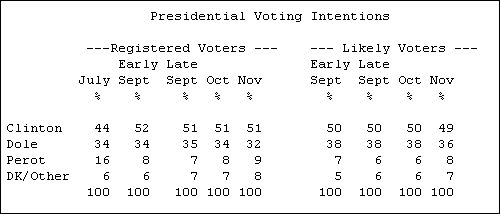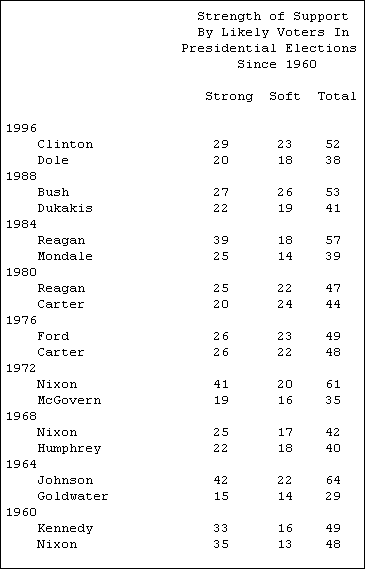Survey Findings
Bill Clinton’s lead over Bob Dole and Ross Perot remains as wide and deep at the end of the final week of the campaign as it has been for the past two months, despite the growing controversy about Democratic campaign finance irregularities. The Pew Research Center’s final survey of 1,211 likely voters, taken October 31 through November 3, finds 49% supporting Clinton, 36% Dole, 8% Perot, 1% other candidates, with 6% undecided. When the undecided voters are allocated, the Center’s best estimate of the probable outcome of the election is 52% for Clinton, 38% for Dole, 9% for Perot, and 1% for other candidates.

Voters favor Democratic candidates over Republicans for the House of Representatives by a much narrower margin: 48% of likely voters say they are inclined to back a Democratic candidate in their district, 44% a Republican candidate, with 8% undecided. These figures are virtually unchanged from those obtained in a comparable nationwide survey conducted two weeks ago.
However, like previous surveys, the current poll continues to indicate that most voters (60%) think their incumbent deserves reelection and voters feel that local rather than national issues are influencing their congressional voting intentions. Both findings would cut against a change in party control of Congress. These findings, along with the fact that the generic measure of party support for the House is a less accurate predictor of the popular vote in presidential years than in off years, make it impossible to conclude based on this survey that the Democrats will wrest control of the Congress from the GOP.

The outcome of the presidential election looks more certain. Clinton’s strong support compares favorably with that of other winning presidential candidates in the final Gallup Polls 1960- 1988. (See trend table) The number of voters who say they might switch to another candidate has fallen for all three contenders over the past month as the electorate firms up its choice. Just 8% of voters say they might change their minds and vote for Dole. Perot’s support is marginally higher in the current poll than in the Center’s mid- October survey (8% vs. 6%), but only another 7% of voters say they might reconsider and support him. The Reform Party candidate is only getting the support of 29% of those who say they voted for him in 1992.
Potential damage from recent disclosures of campaign finance irregularities appears to be less than anticipated. Only half of voters say they have been closely following the news about charges of improper campaign contributions to the Democrats by Indonesian business interests (23% very closely, 33% fairly closely). And merely 7%of Clinton backers say the charges have raised serous doubts in their minds about voting for him.
More broadly, Dole has failed to rally his own Republican Party to his cause in numbers comparable to past GOP standard bearers. Of those self-identifying as Republicans or leaning Republican, 75% say they support him compared to 85% of Democrats and Democrat-leaners supporting Clinton. Other voting blocs traditionally inclined toward the GOP are also showing lukewarm backing for Dole, including white men (39% vs. 41% for Clinton), Evangelical Protestants, and affluent voters.

In contrast, Clinton is benefiting from an unusually high level of loyalty from key Democratic groups, including women (56% vs. 29% for Dole), lower income voters, members of minority groups, and labor union members . On balance, the President is carrying many groups not often found in the Democratic columns in presidential elections, including whites, suburbanites, and middle class Americans. And he has won over swing voters, including Independents (45% vs. 25% for Dole), and white Catholics (53% vs. 29% for Dole).
Nationally, GOP candidates for Congress are getting much more loyalty from party members than Dole – 90% vs 80%. Similarly, GOP candidates are running much stronger than Dole among affluent voters, Independents, and white males. Democrats for Congress are getting more backing from labor than they enjoyed in 1994. In the current poll voters from labor households are supporting Democrats over Republicans by a 60% to 28% margin compared to only 55% to 36% in 1994.
The campaign is closing with Americans expressing record low interest compared to recent elections. Only 34% say they have been following news about the election very closely, compared to 55% in October, 1992 and 43% in October, 1988. Similarly, 67% of registered voters say they have thought quite a lot about the Tuesday elections, compared to 77% in 1992 and 73% in 1988. The Pew Research Center estimates that only about 50% of age eligible voters will cast a ballot next Tuesday.




